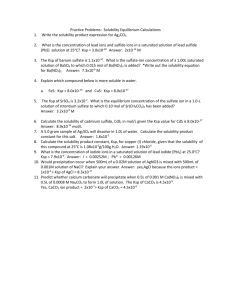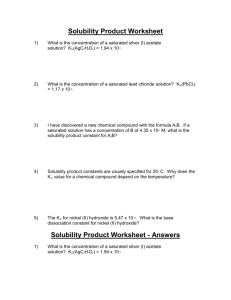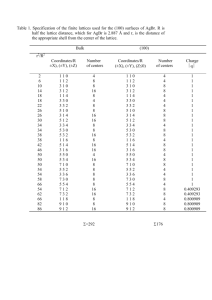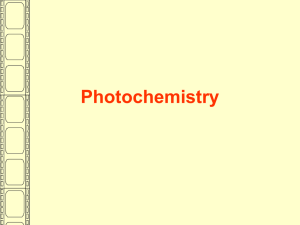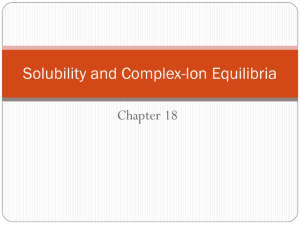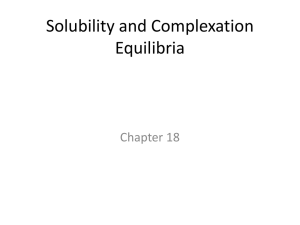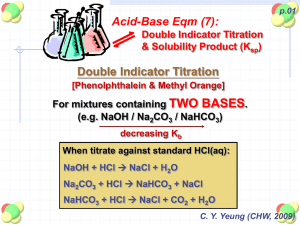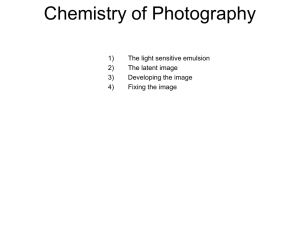AP Free Response Practice
advertisement
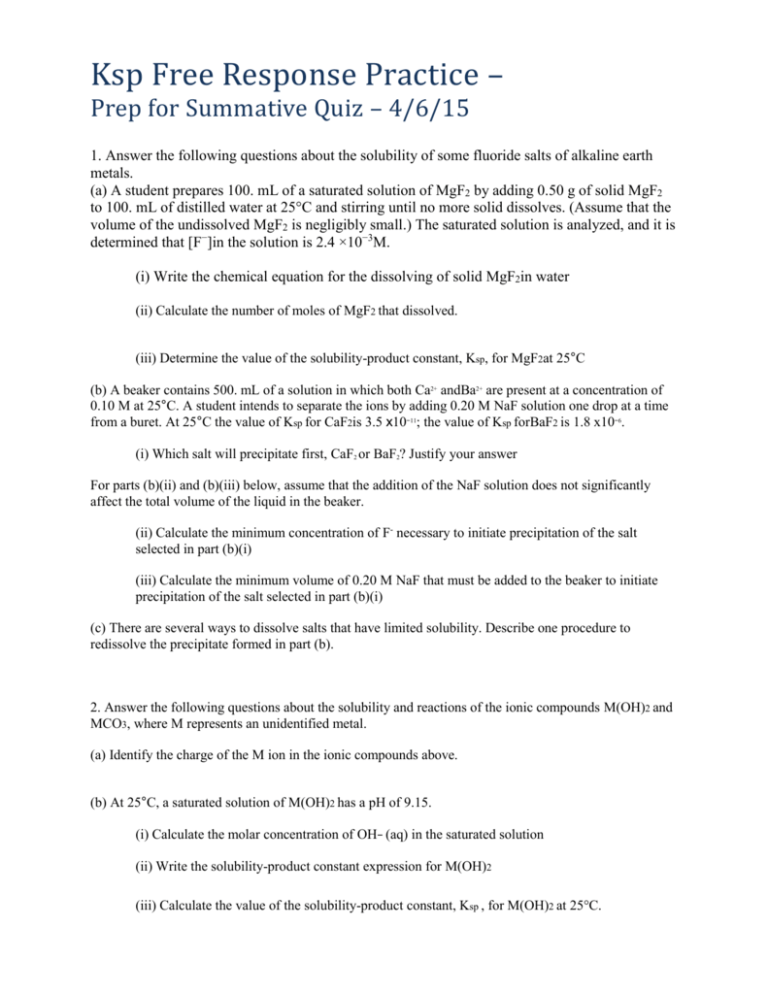
Ksp Free Response Practice – Prep for Summative Quiz – 4/6/15 1. Answer the following questions about the solubility of some fluoride salts of alkaline earth metals. (a) A student prepares 100. mL of a saturated solution of MgF2 by adding 0.50 g of solid MgF2 to 100. mL of distilled water at 25°C and stirring until no more solid dissolves. (Assume that the volume of the undissolved MgF2 is negligibly small.) The saturated solution is analyzed, and it is determined that [F−]in the solution is 2.4 ×10−3M. (i) Write the chemical equation for the dissolving of solid MgF2in water (ii) Calculate the number of moles of MgF2 that dissolved. (iii) Determine the value of the solubility-product constant, Ksp, for MgF2at 25°C (b) A beaker contains 500. mL of a solution in which both Ca2+ andBa2+ are present at a concentration of 0.10 M at 25°C. A student intends to separate the ions by adding 0.20 M NaF solution one drop at a time from a buret. At 25°C the value of Ksp for CaF2is 3.5 x10−11; the value of Ksp forBaF2 is 1.8 x10−6. (i) Which salt will precipitate first, CaF2 or BaF2? Justify your answer For parts (b)(ii) and (b)(iii) below, assume that the addition of the NaF solution does not significantly affect the total volume of the liquid in the beaker. (ii) Calculate the minimum concentration of F- necessary to initiate precipitation of the salt selected in part (b)(i) (iii) Calculate the minimum volume of 0.20 M NaF that must be added to the beaker to initiate precipitation of the salt selected in part (b)(i) (c) There are several ways to dissolve salts that have limited solubility. Describe one procedure to redissolve the precipitate formed in part (b). 2. Answer the following questions about the solubility and reactions of the ionic compounds M(OH)2 and MCO3, where M represents an unidentified metal. (a) Identify the charge of the M ion in the ionic compounds above. (b) At 25°C, a saturated solution of M(OH)2 has a pH of 9.15. (i) Calculate the molar concentration of OH− (aq) in the saturated solution (ii) Write the solubility-product constant expression for M(OH)2 (iii) Calculate the value of the solubility-product constant, Ksp , for M(OH)2 at 25°C. (c) For the metal carbonate, MCO3, the value of the solubility-product constant, Ksp , is 7.4 × 10−14 at 25°C. On the basis of this information and your results in part (b), which compound, M(OH)2 or MCO3 , has the greater molar solubility in water at 25°C ? Justify your answer with a calculation 3. Several reactions are carried out using AgBr, a cream-colored silver salt for which the value of the solubility- product-constant, Ksp, is 5.0 × 10−13 at 298 K. (a) Write the expression for the solubility-product constant, Ksp, of AgBr. (b) Calculate the value of [Ag+] in 50.0 mL of a saturated solution of AgBr at 298 K. (c) A 50.0 mL sample of distilled water is added to the solution described in part (b), which is in a beaker with some solid AgBr at the bottom. The solution is stirred and equilibrium is reestablished. Some solid AgBr remains in the beaker. Is the value of [Ag+] greater than, less than, or equal to the value you calculated in part (b) ? Justify your answer. (d) Calculate the minimum volume of distilled water, in liters, necessary to completely dissolve a 5.0 g sample of AgBr(s) at 298 K. (The molar mass of AgBr is 188 g mol−1.) (e) A student mixes 10.0 mL of 1.5 × 10−4 M AgNO3 with 2.0 mL of 5.0 × 10−4 M NaBr and stirs the resulting mixture. What will the student observe? Justify your answer with calculations. (f) The color of another salt of silver, AgI(s), is yellow. A student adds a solution of NaI to a test tube containing a small amount of solid, cream-colored AgBr. After stirring the contents of the test tube, the student observes that the solid in the test tube changes color from cream to yellow. (i) Write the chemical equation for the reaction that occurred in the test tube. (ii) Which salt has the greater value of Ksp: AgBr or AgI ? Justify your answer.


